
HOTELS IN JORDAN - JORDAN HOTELS
- فنادق الأردن
NEW STEPS Travel & Tourism
Hotel Reservation in Jordan
Phone:
00961 4 713 467 or 00961 4 716 467 or 00961 4 716 649
DISCOUNT UP TO 70%
Book now, pay on check out
Reservation: [email protected]
 You can reserve rooms in any of the Cities
or Regions below,
You can reserve rooms in any of the Cities
or Regions below,
just click on the City or Region of your choice for full listings with description and pictures and then
send us an e-mail with details of your booking.
![]() اللغة العربية
version
fran�aise
اللغة العربية
version
fran�aise
We've reduced our 2012 prices. Click on each hotel for details.
|
Welcome to Jordan We are very pleased that you have decided to visit Jordan. Our Travel Agency is staffed by experienced and efficient personnel fluent in Arabic, English & French.
Our wide range of
services cover the following: We will be glad to assist you during your stay and we will make sure you'll get the best deals available.
|
Select by Location:
|
Your request will be processed very shortly: from 1 to 8 hours if your request reaches us at night!
Welcome to Jordan
The Hashemite Kingdom of Jordan, which once captivated
ancient travelers, continues to enthrall a whole new generation as a modern,
vibrant nation. From the haunting, primeval starkness of Wadi Rum, to the
teeming centre of urban
Amman; from the majestic ruins of bygone civilizations to the timeless
splendor of the Dead Sea, Jordan is unveiled as a unique destination
offering breathtaking and mysterious sights, high standard accommodations,
exquisite cuisine and countless activities that can provide visitors with
inspiration, motivation, and rejuvenation.
centre of urban
Amman; from the majestic ruins of bygone civilizations to the timeless
splendor of the Dead Sea, Jordan is unveiled as a unique destination
offering breathtaking and mysterious sights, high standard accommodations,
exquisite cuisine and countless activities that can provide visitors with
inspiration, motivation, and rejuvenation.
Marveling at herds of gazelles and Oryx and migrating birds, camping amidst the grandeur of Wadi Rum or Dana Reserve, trekking the ancient caravan trails from the highlands of Moab and Edom, hiking the wooded hills of biblical Gilead, or experiencing the unique, cleansing mud baths of the Dead Sea are just a few examples of the treasures awaiting visitors to this unique kingdom.
The new stream of luxury hotels emerging in Amman, Petra, Aqaba and the Dead Sea is just adding quality to a refined product that is distinct, accessible and friendly. A product that is home to a new display of modern meeting facilities and unique venues for incentive travel.
Whether it is a conference for 5000 people, a lavish dinner in the peerless desert of Wadi Rum, a barbecue at the shores of the Dead Sea ( the lowest point on earth ), or a reception atop a medieval castle overlooking the Jordan Valley, the amicable and competent people of Jordan will ensure a once in a life time memorable experience.
Jordan, a young country dense with history, full of
natural wonders and historical sites, a well-travelled bridge between sea and
desert, east and west. Situated just east of the River Jordan, it continues to
be a bridge between ancient and new civilizations and an open air museum in
almost all its entirety.
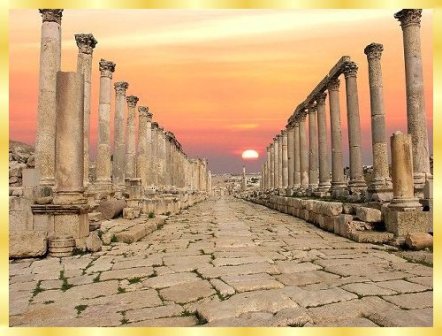
Jordan is a country for all seasons. In winter it offers therapy at the Dead Sea, the lowest point on earth where "floating" rather than "swimming" is a unique adventure in the extremely saline and mineral rich waters.
In summer, Petra, the ancient rose-red city carved in mountain rock is your ultimate, and astonishing destination. It is as beautiful to see as are northern parts of the country, Umm Qais, Jerash with its wonderfully preserved Roman ruins, or the capital, Amman, and the mosaic city of Madaba. A world of mystery and wonderful hospitality is open for you just east of the River Jordan.
Shopping bargains, souvenirs, excellent oriental and international cuisine, aromas, flavours, colors and most of all smiling people will mix and blend to make your stay in Jordan an unforgettable one.
The adventurous travelers can practice year round a variety of water sports at the resort of Aqaba, on the Red Sea, home of one of the best coral reefs in the world.
The more romantic visitor can camp in bedouin tents or sleep right under the stars, climb mountains or ride camels on the very trek followed in desert of Wadi Rum by Lawrence of Arabia.
|
Wadi Rum Hotels |
||
| Home |
|
General Information about Jordan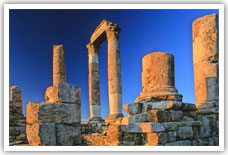
Images of the ancient
Nabatean city of Petra, carved from the rock over a thousand years ago, have
long been most people�s first impression of Jordan.
But while Petra is indeed one of the most stunning attractions in the Middle
East, Jordan offers so much more for the modern traveller.
A well-travelled bridge between sea and desert, east and west, the Hashemite
Kingdom of Jordan is a land of mesmerizing beauty and contrasts, from the Jordan
Valley, fertile, ever changing, to the remote desert canyons, immense and still.
Visitors can explore splendid desert castles, gaze in awe at the haunting
wilderness of Wadi Rum, or bathe in the restful waters of the Red Sea.
For adventure lovers, there�s horse riding, 4x4 safaris, rock climbing and
hiking. For taking it easy, nothing on earth compares to the Red Sea and its
many spa facilities.
Modern Jordan was founded by King Abdullah I after World War I. It was ruled by
his grandson, The Late King Hussein, for 46 years until his death in 1999, when
his son King Abdullah II assumed the throne. Jordan has grown into a modern
nation which has enjoyed a remarkable measure of peace, stability and economic
growth in recent decades.
Where to go in Jordan
Amman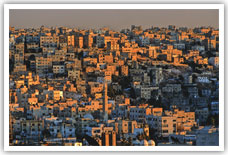
A modern city built on the sands of time
Amman, the capital of Jordan, is a fascinating city of contrasts � a unique blend of old and new, ideally situated on a hilly area between the desert and the fertile Jordan Valley.
In the commercial heart of the city, ultra-modern buildings, hotels, smart restaurants, art galleries and boutiques rub shoulders comfortably with traditional coffee shops and tiny artisans' workshops. Everywhere there is evidence of the city�s much older past.
The downtown area is much older and more traditional
with smaller businesses producing and selling everything from fabulous jewellery
to everyday household items.
The people of Amman are multi-cultural, multi-denominational, well educated and
extremely hospitable. They welcome visitors and take pride in showing them
around their fascinating and vibrant city.
|
Wadi Rum Hotels |
||
| Home |
|
Jordan Valley & the Dead Sea
Nature's living miracle, a
place to rejuvenate and restore both body and soul
Without
doubt, the world�s most amazing place, the Jordan Rift Valley is a dramatic,
beautiful landscape, which at the Dead Sea, is over 400 metres (1,312 ft.) below
sea level. The lowest point on the face of the earth, this vast, stretch of
water receives a number of incoming rivers, including the River Jordan. Once the
waters reach the Dead Sea they are land-locked and have nowhere to go, so they
evaporate, leaving behind a dense, rich, cocktail of salts and minerals that
supply industry, agriculture and medicine with some of its finest products.
The Dead Sea is flanked by mountains to the east and the rolling hills of
Jerusalem to the west, giving it an almost other-worldly beauty. Although
sparsely populated and serenely quiet now, the area is believed to have been
home to five Biblical cities: Sodom, Gomorrah, Adman, Zebouin and Zoar.
One of the most spectacular natural and spiritual landscapes in the world, the Jordanian east coast of the Dead Sea has evolved into a major hub of both religious and health & wellness tourism in the region. A series of good roads, excellent hotels with spa and fitness facilities, as well as archaeological and spiritual discoveries make this region as enticing to today�s international visitors as it was to kings, emperors, traders, prophets and pilgrims in antiquity.
The leading attraction at the Dead Sea is the warm, soothing, super salty water itself � some ten times saltier than sea water, and rich in chloride salts of magnesium, sodium, potassium, bromine and several others. The unusually warm, incredibly buoyant and mineral-rich waters have attracted visitors since ancient times, including King Herod the Great and the beautiful Egyptian Queen, Cleopatra. All of whom have luxuriated in the Dead Sea�s rich, black, stimulating mud and floated effortlessly on their backs while soaking up the water's healthy minerals along with the gently diffused rays of the Jordanian sun.
Petra
"a rose red city half as old as
time"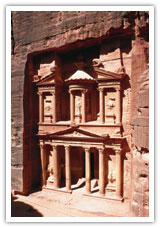
The giant red mountains and vast mausoleums of a
departed race have nothing in common with modern civilization, and ask nothing
of it except to be appreciated at their true value - as one of the greatest
wonders ever wrought by Nature and Man.
Although much has been written about Petra, nothing really prepares you for this
amazing place. It has to be seen to be believed.
Petra the world wonder, is without doubt Jordan�s most valuable treasure and
greatest tourist attraction. It is a vast, unique city, carved into the sheer
rock face by the Nabataeans, an industrious Arab people who settled here more
than 2000 years ago, turning it into an important junction for the silk, spice
and other trade routes that linked China, India and southern Arabia with Egypt,
Syria, Greece and Rome.
Entrance to the city is through the Siq, a narrow
gorge, over 1 kilometre in length, which is flanked on either side by soaring,
80 metres high cliffs. Just walking through the Siq is an experience in itself.
The colours and formations of the rocks are dazzling. As you reach the end of
the Siq you will catch your first glimpse of Al-Khazneh (Treasury).
This is an awe-inspiring experience. A massive fa�ade, 30m wide and 43m high,
carved out of the sheer, dusky pink, rock-face and dwarfing everything around
it. It was carved in the early 1st century as the tomb of an important Nabataean
king and represents the engineering genius of these ancient people.
The Treasury is just the first of the many wonders that make up Petra. You will need at least four or five days to really explore everything here. As you enter the Petra valley you will be overwhelmed by the natural beauty of this place and its outstanding architectural achievements. There are hundreds of elaborate rock-cut tombs with intricate carvings - unlike the houses, which were destroyed mostly by earthquakes, the tombs were carved to last throughout the afterlife and 500 have survived, empty but bewitching as you file past their dark openings. Here also is a massive Nabataean-built,
Roman-style theatre, which
could seat 3,000 people. There are obelisks, temples, sacrificial altars and
colonnaded streets, and high above, overlooking the valley, is the impressive
Ad-Deir Monastery � a flight of 800 rock cut steps takes you there.
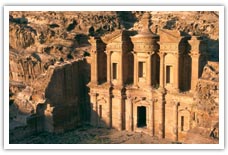
Within the site there are also two excellent museums; the Petra Archaeological
Museum and the Petra Nabataean Museum both of which represent finds from
excavations in the Petra region and an insight into Petra's colourful past.
A 13th century shrine, built by the Mameluk Sultan Al Nasir Mohammad to
commemorate the death of Aaron, the brother of Moses, can be seen on top of
Mount Aaron in the Sharah range.
Inside the site, several artisans from the town of Wadi Musa and a nearby Bedouin settlement have set up small stalls selling local handicrafts, such as pottery and Bedouin jewellery and bottles of striated multi-coloured sands from the area.
It is not permitted for motorized vehicles to enter the site. But if you don�t want to walk, you can hire a horse or a horse-drawn carriage to take you through the one kilometre Siq. For the elderly and/or handicapped, the Visitors' Centre, close to the entrance of the Siq, will issue a special permit (at an extra fee), for the carriage to go inside Petra to visit the main attractions. Once inside the site, you can hire a donkey, or for the more adventurous, a camel - both come with handlers and take designated routes throughout the site.
Petra was first established sometime around the 6th century BC, by the Nabataean Arabs, a nomadic tribe who settled in the area and laid the foundations of a commercial empire that extended into Syria.
Despite successive attempts by the Seleucid king
Antigonus, the Roman emperor Pompey and Herod the Great to bring Petra under the
control of their respective empires, Petra remained largely in Nabataean hands
until around 100AD, when the Romans took over. It was still inhabited during the
Byzantine period, when the former Roman empire moved its focus east to
Constantinople, but declined in importance thereafter.
The Crusaders constructed a fort there in the 12th century, but soon withdrew,
leaving Petra to the local people until the early 19th century, when it was
rediscovered by the Swiss explorer Johann Ludwig Burckhardt in 1812.
|
Wadi Rum Hotels |
||
| Home |
|
Wadi Rum
"the crimson sunset on its
stupendous cliffs and slanted ladders of hazy fire down its walled avenue"
This is a stupendous, timeless place, virtually untouched by humanity and its destructive forces. Here, it is the weather and winds that have carved the imposing, towering skyscrapers, so elegantly described by T.E. Lawrence as �vast, echoing and god-like�..
A maze of monolithic rockscapes rise up from the desert floor to heights of 1,750 metres creating a natural challenge for serious mountaineers. Hikers can enjoy the tranquility of the boundless empty spaces, explore the canyons and water holes to discover 4000 year old rock drawings and the many other spectacular treasures this vast wilderness holds in store.
Also known as �The Valley of the Moon�, this is the place where Prince Faisal Bin Hussein and T.E. Lawrence based their headquarters during the Arab Revolt against the Ottomans in World War 1, and their exploits are intrinsically woven into the history of this amazing area.
There are several options for exploring Wadi Rum. Visitors should head for the Visitors Centre where, apart from visitors� facilities, they can hire a 4x4 vehicle, together with driver/guide, and then drive for two or three hours into the Wadi system to explore some of the best known sites. Alternatively they can hire a camel and guide. The duration of the trip can be arranged beforehand through the Visitors Centre, as can a stay under the stars in a Bedouin tent, where they can enjoy a traditional campfire meal accompanied by Arabic music.
Once transport has been
arranged, there are various excursions available - for example, a trip to Burdah
Rock Bridge, the highest in Wadi Rum, via the Seven Pillars of Wisdom and many
other interesting sights, is a full day by car or an overnight trip by camel.
There are many alternative routes and information on these is available from
your tour operator or from the Visitors Centre on-site.
The Bedouin people that inhabit the area still maintain their semi-nomadic
lifestyle. They are hospitable and offer a friendly welcome to visitors, often
inviting them to sit and enjoy a coffee or even a meal.
Aqaba
Discover the delights of
Jordan's Red sea resort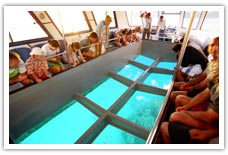
With its wealth of other attractions, Jordan�s
splendid Red Sea resort is often overlooked by modern-day visitors. But apart
from being a delightful place for discerning holidaymakers, this is actually a
great base from which to explore various places of interest in southern Jordan.
Aqaba is a fun place. It is a microcosm of all the good things Jordan has to
offer, including a fascinating history with some outstanding sites, excellent
hotels and activities, superb visitor facilities, good shopping, and welcoming,
friendly people, who enjoy nothing more than making sure their visitors have a
good time.
But perhaps Aqaba�s greatest asset is the Red Sea
itself. Here you can experience some of the best snorkelling and diving in the
world. The temperate climate and gentle water currents have created a perfect
environment for the growth of corals and a teeming plethora of marine life. Here
you can swim with friendly sea turtles and dolphins as they dart amongst the
schools of multicoloured fish. Night dives reveal the nocturnal sea creatures,
crabs, lobsters and shrimp, as they search for a midnight snack.
There are several dive centres in Aqaba. All offer well-maintained diving
equipment, professional instructors, and transport by boat to a variety of dive
sites.
For those who prefer to keep their feet dry, all the deep
sea wonders can be viewed through a glass-bottomed boat or by submarine, or you
can just relax under the sun on the resort�s sandy beaches. Plus, of course,
there are plenty of other water-sport activities available, as well as an
extensive and interesting Marine Park.
From as far back as five and half thousand years ago Aqaba
has played an important role in the economy of the region. It was a prime
junction for land and sea routes from Asia, Africa and Europe, a role it still
plays today. Because of this vital function, there are many historic sites to be
explored within the area, including what is believed to be the oldest
purpose-built church in the world.
Aqaba International Airport is situated just a 20-minute drive from the town
centre and services regular flights from Amman as well as from several European
cities. From the town centre, the borders of Israel, Egypt�s Sinai and Saudi
Arabia are no more than a 30-minute drive.
|
Wadi Rum Hotels |
||
| Home |
|
Madaba
Just 30 kilometres from Amman, along the
5,000-year-old Kings� Highway, is one of the most memorable places in the Holy
Land. After passing through a string of ancient sites, the first city you reach
is Madaba, known as the �City of Mosaics".
Best known for its spectacular Byzantine and Umayyad mosaics, Madaba is home to
the famous 6th century Mosaic Map of Jerusalem and the Holy Land. With two
million pieces of vividly colored local stone, it depicts hills and valleys,
villages and towns as far as the Nile Delta.
The Madaba Mosaic Map covers the floor of the Greek
Orthodox Church of St. George, which is located northwest of the city centre.
The church was built in 1896 AD, over the remains of a much earlier 6th century
Byzantine church. The mosaic panel enclosing the Map was originally around 15.6
X 6m, 94 square meters, only about a quarter of which is preserved.
6th century
Byzantine church. The mosaic panel enclosing the Map was originally around 15.6
X 6m, 94 square meters, only about a quarter of which is preserved.
Other mosaic masterpieces found in the church of the Virgin and the Apostles and
in the Archaeological Museum, depict a rampant profusion of flowers and plants,
birds and fish, animals and exotic beasts, as well as scenes from mythology and
the everyday pursuits of hunting, fishing and farming. Literally, hundreds of
other mosaics from the 5th through the 7th centuries are scattered throughout
Madaba's churches and homes.
In line with Jordan's commitment to restoring and preserving its mosaic masterpieces, Madaba�s extensive archaeological Park and Museum complex encompasses the remains of several Byzantine churches, including the outstanding mosaics of the Church of the Virgin and the Hyppolytus Hall, part of a 6th century mansion.
Close to the Church of the Virgin is the Madaba Institute For Mosaic Art and Restoration, which operates under the patronage of the Ministry of Tourism. The only project of its kind in the Middle East, the Institute trains artisans in the art of making, repairing and restoring mosaics.
Hammamat Ma'in
Southwest of Madaba is Hammamat Ma�in, the thermal
mineral springs that for centuries have attracted people to come and immerse
themselves in the sites� warm therapeutic waters. There is an excellent 4-star
hotel here, which offers indoor and natural outdoor hot pools, a swimming pool
and spa facilities.
|
Wadi Rum Hotels |
||
| Home |
|
Bethany beyond the Jordan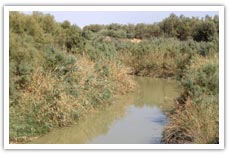
The Bethany area sites formed part of the early Christian pilgrimage route between Jerusalem, the Jordan River, and Mount Nebo.
The area is also associated with the biblical account of how the Prophet Elijah (Mar Elias in Arabic) ascended to heaven in a whirlwind on a chariot of fire. (See main Image above).
What to do in Jordan
Fun & Adventure in Jordan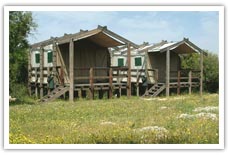
Outdoor 'Adventure Tourism' is expanding at a fast rate in Jordan, and promises to remain one of the most dynamic and innovative travel industry sectors for years to come. Several Jordanian companies have started to specialize in eco-tourism and action tourism, providing the combination of safety, adventure, and comfortable facilities that make action tourism such an exciting proposition today.
Jordan has great comparative advantage in this sector, based on several assets: guaranteed sunshine for eight months of the year; a base of powerful, unique cultural attractions such as Petra, Jerash, Bethany Beyond the Jordan, and the early Islamic Desert Castles; and, a wide range of very different, often stunning natural environments that are easily accessible and virtually undiscovered by the tourism industry. Quality hotels and restaurants throughout the country mean that thrill-seekers who want to pamper themselves in between adventure treks have a wide range of facilities to choose from.
Jordan already caters to the more traditional
vacationer who likes to combine a visit to an ancient site in the morning with a
swim, a round of golf, or a game of tennis or bowling in the afternoon. The
exciting new horizons in adventure tourism allow visitors to push themselves to
new levels of adventure and endurance while soaking up natural marvels and
dramatic cultural attractions from the ancient world.
For example, a small group of people in 4-wheel-drive vehicles can retrace the
journey of the Emperor Hadrian from north to south Jordan, taking in biblical
cities and legionary fortresses. Or, more ambitiously, a caravan of 25 people on
camels or donkeys can set off to retrace the journeys of Lawrence of Arabia in
the central highlands and eastern deserts of Jordan, spending a week en route
and camping in a different place every night. Parts of these itineraries can be
done along the edge of the desert in steam-powered World War One vintage trains,
the same as those that were attacked by the forces of the Great Arab Revolt and
Lawrence nearly a century ago.
Nature enthusiasts have many options in Jordan: the
vast, silent drama of Wadi Rum, the forested hills of central Jordan, or the
plunging Jordan Rift Valley that includes the Dead Sea - the lowest spot on
earth at 410 metres below sea level. The Red Sea resort of Aqaba is always warm,
balmy, and enticing for divers and other watersports enthusiasts. Aqaba offers a
full range of facilities for speedboating, scuba diving, snorkelling, sailing,
fishing, swimming, water skiing, wind surfing, or simply loafing and sunning in
the warm crystal-clear waters of the Red Sea. The sparkling purple mountains
surrounding Aqaba beckon hikers who seek new adventures, and unconquered
terrain.
Jordan boasts other unique, enticing waters that provide relaxing interludes for adventure vacationers who want to rest their spirits and soak their bodies. Quality hotels and spas at the Dead Sea and the nearby Hammamat Zarqa Ma'in Springs allow visitors to experience several different kinds of mineral hot springs and the thick, warm brine of the Dead Sea, which are both soothing and therapeutic. One of the great water adventures in Jordan is to hike, climb and sometimes even wade or swim through the magnificent gorge of the Wadi Mujib, along the east coast of the Dead Sea, to reach a magical pool and waterfall that emerge like a mirage from amidst the surrounding warm cliffs and barren hillsides.
The more daring adventure visitor to Jordan is likely to climb mountains in Wadi Rum to conquer sheer granite cliffs that retain the inscriptions of local climbers who were there 5000 years ago and more.
Thrill-seekers who want to go beyond the ordinary
will get into a helicopter or hot air balloon and rise to mountain-tops in Wadi
Rum or around Petra, from where they can trek back down to earth. Gliding and
private plane rentals are also available in Jordan, only from Marka Airport in
Amman.
Horseback riders can take a few days to retrace the segments of the ancient
Spice, Silk, and Frankincense Routes that pass through the green hills of Petra,
Amman, and north Jordan. More daring riders will want to mount their Arabian
steeds for a four-day trek through the eastern desert, stopping for rest and
water at several early Islamic desert castles and caravan stations. This trip
re-enacts the original Arabian pony express mail service that operated here in
the 7th century.
|
Wadi Rum Hotels |
||
| Home |
|
History & Culture in Jordan
There is no mistaking the fact that Jordan is a Kingdom steeped in history and culture. From the moment you arrive, you get a sense of its rich heritage, all around are remnants of ancient civilizations long since past, yet they still remain, stamped into the very fabric of this amazing Kingdom and etched into the soul of the people who live here.
Eco & Nature in Jordan
Ajloun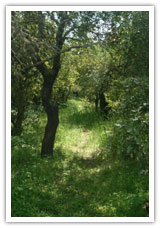
Ajloun Nature Reserve is located in the Ajloun highlands (North of Amman), It consists of Mediterranean-like hill country, dominated by open woodlands of Oak and Pistachio trees. The Reserve was first established in 1988 when a captive-breeding programme for the Roe Deer was initiated. The reserve is located in an area named Eshtafeena. The Royal Society for the Conservation of Nature has set up two hiking trails and provided a special area for camping. Ajloun's woodlands consist mostly of Oak trees, interspersed with Pistachio, Pine, Carob, and Wild Strawberry trees. These trees have been important to local people for their wood, scenic beauty, and quite often for medicine and food.
Aqaba Protected Area
The Gulf of Aqaba is famous for its marine wildlife.
It is the north-eastern arm of the Red Sea, measuring a length of 180 kilometres
and expanding to a width of 25 kilometres, with a shoreline shared by Egypt,
Saudi Arabia, Israel, and Jordan.
The Gulf of Aqaba has the world�s northernmost coral reef ecosystem. An average
water temperature of 23� Celsius, the absence of stormy weather, and mild water
currents have created a hospitable environment for the growth of corals.
Favourable salinity levels are perfect for the myriads of other marine
life-forms. As a result, it is home to 110 species of soft corals and 120
species of hard corals. The reefs which fringe the Gulf, host over 1000 species
of fish, corals, crustaceans, and mammals living in its waters. Nocturnal
animals such as the crab, shrimp, and lobster appear in search of food in the
dark hours of the night. Seasonal visitors to the Gulf of Aqaba include sea
turtles, dolphins, sea cows, and harmless whale sharks.
Aqaba is the only coastal city in Jordan. This beautiful town, surrounded by
fascinating colourful mountains and the blue waters of the Red Sea, expands over
27 kilometres of shoreline on the Gulf of Aqaba. The town is well organized, and
under continuous development. It has been designated as a Special Economic Zone,
with special legislation to protect and improve its business, community, tourism
and environment status.
Azraq
Azraq is a unique wetland oasis located in the heart of the semi-arid Jordanian eastern desert, one of several beautiful nature reserves managed by the Royal Society for the Conservation of Nature (RSCN). Its attractions include several natural and ancient built pools, a seasonally flooded marshland, and a large mudflat know as Qa'a Al-Azraq. A wide variety of birds stop at the reserve each year for a rest during their arduous migration routes between Asia and Africa. Some stay for the winter or breed within the protected
Dana
Dana Nature Reserve covers 308 square kilometres and is a world of natural treasures. It is composed of a chain of valleys and mountains which extend from the top of the Jordan Rift Valley down to the desert lowlands of Wadi Araba. The visitor to this area will be awed by the beauty of the Rummana mountain, the mystery of the ancient archaeological ruins of Feinan, the timeless serenity of Dana Village and the grandeur of the red and white sandstone cliffs of Wadi Dana. The Reserve contains a remarkable diversity of landscapes, that range from wooded highlands to rocky slopes and from gravel plains to dunes of sand. Moreover, Dana supports diverse wildlife which includes a variety of rare species of plants and animals; Dana is home to about 600 species of plants, 37 species of mammals and 190 species of birds.
Mujib
The Mujib Reserve is the lowest nature reserve in the world, with a spectacular array of scenery near the east coast of the Dead Sea. The reserve is located within the deep Wadi Mujib gorge, which enters the Dead Sea at 410 metres below sea level. The Reserve extends to the Karak and Madaba mountains to the north and south, reaching 900 metres above sea level in some places. This 1,300 metre variation in elevation, combined with the valley's year- round water flow from seven tributaries, means that Wadi Mujib enjoys a magnificent bio-diversity that is still being explored and documented today. Over 300 species of plants, 10 species of carnivores and numerous species of permanent and migratory birds have been recorded. Some of the remote mountain and valley areas are difficult to reach, and thus offer safe havens for rare species of cats, goats and other mountain animals. Mujib's sandstone cliffs are an ideal habitat for one of the most beautiful mountain goats in the world, the horned Ibex.
Shawmari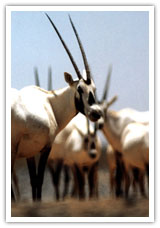
The Shawmari Reserve was created in 1975 by the RSCN as a breeding centre for endangered or locally extinct wildlife. Today, following breeding programmes with some of the world's leading wildlife parks and zoos, this small, 22-square-kilometre reserve is a thriving protected environment for some of the most rare species of animals in the Middle East. Oryx, ostriches, gazelles and onagers, which are depicted on many 6th Century Byzantine mosaics, are rebuilding their populations and reasserting their presence in this safe haven, protected from hunting and habitat destruction that nearly wiped them out.
Wadi Rum Protected Area
The moonlike landscape of Wadi Rum is unique in the
world. The desert of Rum is dotted with massive mountains, coloured in shades of
red, yellow, and orange. Their hues spill over to colour the sand dunes around
the desert and the horizon of its breathtaking panorama.
This is a place where you can become one with nature, where visitors are humbled
by the towering mountains and overwhelmed by the serenity and quiet ambiance of
this magnificent place.
The eco-system of Wadi Rum holds many rare and endemic plants. Spring reveals
hundreds of species of wild flowers. About 120 bird species have been recorded
in the area, including the Griffon Vulture, the Fan-Tailed Raven, Bonelli�s
Eagle, and Hume�s Tawny Owl. Baseline surveys show the existence of the Grey
Wolf, Blandford�s Fox, the Sand Cat, and Ibex within the area.
One activity which keeps attracting thrill-seekers to Wadi Rum is mountain
climbing. Ascents can range from simple hikes to serious mountain climbing more
than 900 metres up sheer granite and sandstone cliffs.
|
Wadi Rum Hotels |
||
| Home |
|
Leisure & Wellness in Jordan
The popularity of the spa vacation has increased worldwide as many people are adopting healthier lifestyles. For this reason, Jordan has complimented its natural therapeutic sites with first class resorts offering a diverse range of amenities. The goal is to provide its visitors with a unique and relaxing experience catering to all of their health and fitness and beauty needs.
Religion & Faith in Jordan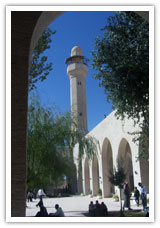
Jordan is a modern country with an ancient culture, a
land of which visitors can walk through the valleys, hills and plains whose
names have become part of human history by virtue of the simple deeds and
profound messages of prophets who walked the land and crossed its rivers during
their lives.
Many of the sites where they are said to have performed miracles or reached out
to ordinary people have been identified, excavated and protected, and are now
more easily accessible to visitors.
Jordan is an ideal destination for those seeking cultural knowledge and spiritual enrichment. Jordan values its ethnically and religiously diverse population, consequently providing for the cultural rights of all its citizens. This spirit of tolerance and appreciation is one of the central elements contributing to the stable and peaceful cultural climate flourishing within Jordan. More than 92% of Jordanians are Sunni Muslims and approximately 6% are Christians. The majority of Christians belong to the Greek Orthodox Church, but there are also Greek Catholics, a small Roman Catholic community, Syrian Orthodox, Coptic Orthodox, Armenian Orthodox, and a few Protestant denominations. Several small Shi'a and Druze populations can also be found in Jordan.
As Jordan is an Islamic state, one may explore the principles of Islam through direct interaction with the people of this monotheistic religion. As the capstone of a long tradition beginning with Judaism and Christianity, Muslims believe that Islam completes the revelation of God's message to humankind. Islam � which in Arabic means "submission" - is an assertion of the unity, completeness, and sovereignty of God. Muslims believe that God, or Allah, as He is known in Arabic, revealed his final message to humankind through the Prophet Muhammad (PBUH) and the Holy Qur'an, which is the divine immutable word of God. Islam focuses heavily on the equality of all humans before the one true God, and therefore it is in many ways a return to the original doctrine of the pure monotheism that characterized the early Judeo-Christian tradition.
Islamic tradition has crystallized five fundamental observances, or "pillars", that are as important as faith in defining Islamic identity and strengthening the common bond that ties all Muslims together. They are Confession of Faith, Daily Prayer (five times per day facing the holy city of Mecca), Fasting during the Islamic holy month of Ramadan, Alms giving, and Pilgrimage to Mecca.
|
Wadi Rum Hotels |
||
| Home |
|
Choose your language:
|
idioma espa�ol |
Russian French Spanish German Italian Dutch Portuguese Norwegian
Lebanon Hotels Syria Hotels Lebanon Hotels Lebanon Hotels Jordan Hotels Lebanon Hotels Lebanon Hotels Lebanon Hotels Lebanon Hotels Lebanon Hotels Lebanon Hotels Lebanon Hotels Jordan Hotels Jordan Hotels Jordan Hotels Jordan Hotels Jordan Hotels Lebanon Hotels Lebanon Hotels Syria Hotels